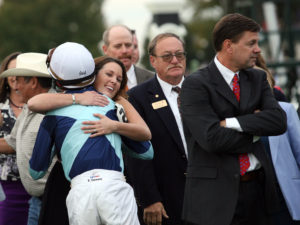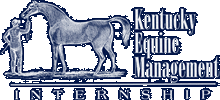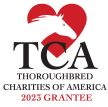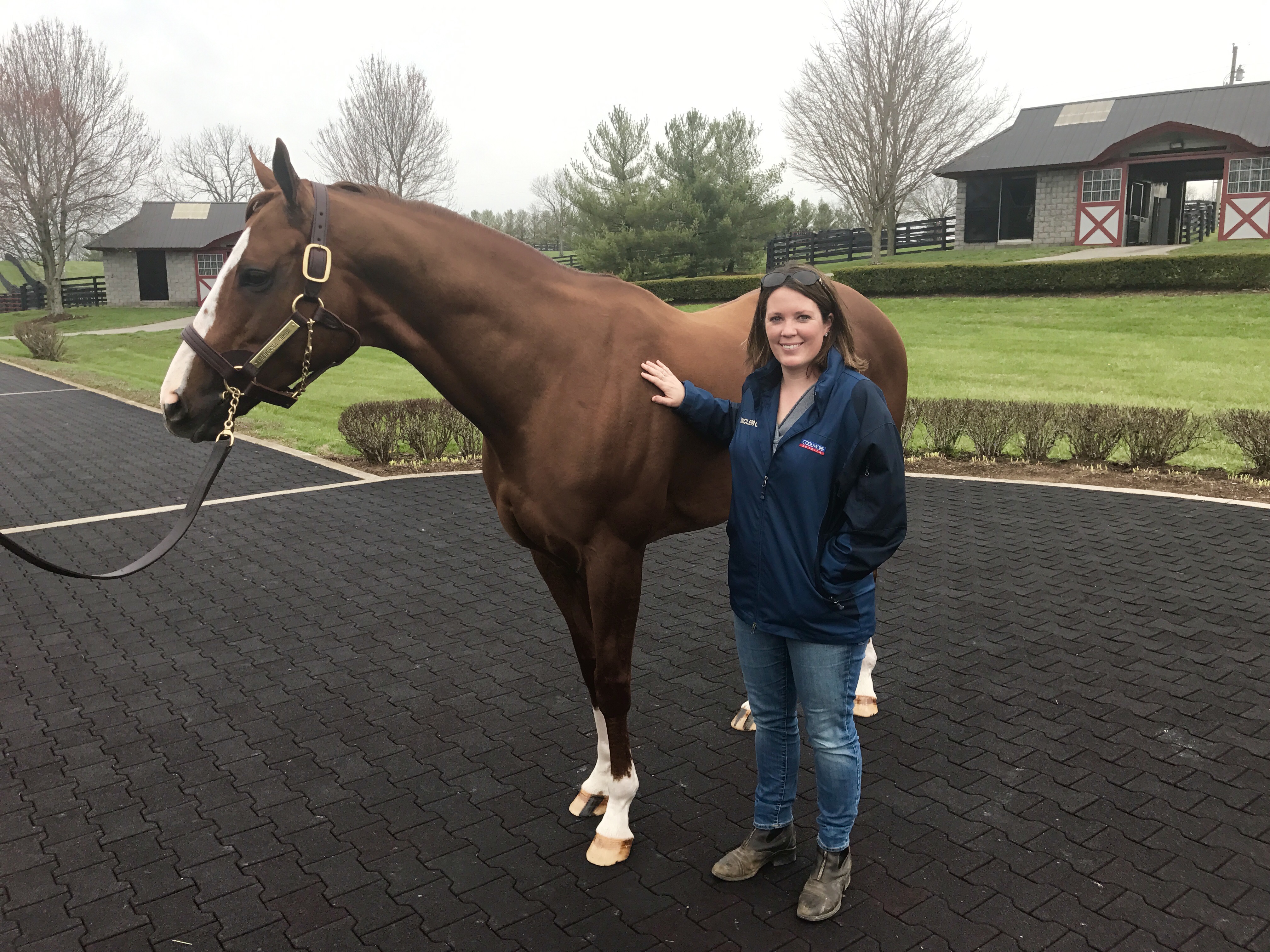
Now a prominent fixture in the Thoroughbred industry, Carrie Gilbert grew up a track rat in Fairport, N.Y., before moving to the Horse Capital of the World and immersing herself in all things equine.
Starting ‘Em Off Right
Having grown up riding hunter/jumpers and showing on the Arabian show circuit, Carrie Gilbert was immersed in the show world as a child. However, she got her first taste of Thoroughbred racing at the tender age of 6, when her great-aunt brought her to Saratoga Race Course for the first time. Carrie knew then and there that she was wanted to work horses—and not just horse: racehorses.
Carrie went to the track every summer after that, spending days on the backside and going to the races. Her aunt worked part-time as a betting window teller on weekends, so she would take Carrie with her and drop her off on the backside, where she would spend the entire morning. From there, Carrie would walk to the Museum of Racing and Hall of Fame and then head back to the track for the afternoon races.
Right Where She’s Meant to Be
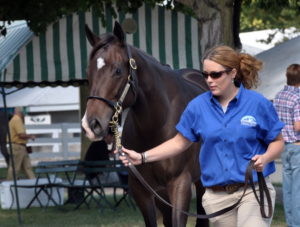 The time spent on the track solidified Carrie’s conviction that she was meant to live in Kentucky, so immediately upon graduating from high school, she accepted a groom position at Lane’s End Oak Tree division. She jumped in head first, learning how to groom and the ropes of how a first-class Thoroughbred farm operated.
The time spent on the track solidified Carrie’s conviction that she was meant to live in Kentucky, so immediately upon graduating from high school, she accepted a groom position at Lane’s End Oak Tree division. She jumped in head first, learning how to groom and the ropes of how a first-class Thoroughbred farm operated.
Carrie first became aware of the KEMI program after only two weeks in the Bluegrass, when students came to Lane’s End Oak Tree for their short course, which is a series of orientation activities KEMI members take part in as a group. The short course is designed to help students get acquainted with the expectations of the KEMI program, learn about job opportunities for graduates and get a general overview of the components of the Kentucky Thoroughbred industry.
The KEMI students happened to be at Lane’s End to hear lectures from farm employees on how they manage their operations and to see the farm in action. Once the tour had left, Carrie’s manager, Callan Strouss, encouraged her to apply for a spot in the highly competitive program even though the deadline for acceptance had passed by just a few days. “The rest is history!” Carrie laughs.
Immersion In the Industry
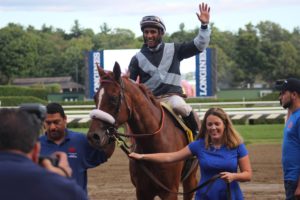
As she was brand-new to the Bluegrass, it would have been understandable if Carrie was plagued by a nerves before entering the KEMI program. But when asked if she was anxious, Carrie said she wasn’t at all—she was simply excited. “This [program] allowed me to meet people my own age working in similar positions who also had a passion for all things equine. The opportunities to learn, grow and network appeared endless!”
When asked what her favorite part of the KEMI program was, Carrie couldn’t narrow it down to just one thing. “Honestly, I really enjoyed everything about it. I thrived on the lectures and guest speakers; I was thrilled to be able to attend clinics, symposiums and the monthly Farm Managers Club meetings.”
While it might seem like the last thing KEMI students might be interested in doing after working long hour on the farm is go to class, Carrie related that the weekly lectures are actually very well received. “They give you an opportunity to catch up with the other interns in the program; to swap stories and hang out, which I think is important as farm life can get busy and rather tiring–having friends in the same situation is good to have.”
As the goal of KEMI is to completely immerse students in the program, Carrie also go to see firsthand the ins and outs of an industry she knew she had always wanted to be involved in. “To be able to handle, care for and help raise some of the best equine athletes in the world was priceless,” she explains. “You form relationship with the management and staff on the farm along with the veterinarians, farriers and so many more key figures who can you can easily call upon in the future for just about anything.”
Carrie has a long list of key people who were mentors during her time in KEMI, all of whom she still considers mentors and friends today. When asked who had an influence on her and whom she still keeps in touch with, Carrie elaborated: “I would have to start off with Callan Strouss and Curt Ramsey [manager and assistant manager at Oak Tree] both of whom I worked for as a KEMI student and still work with daily today. My mentors included Garrett O’ Rourke, Jackie Smith [both at Juddmonte], Sandy Hatfield, Tom Evans, Mike Owens, Bill Wofford, Kim Ramsey [now the Kentucky Thoroughbred Farm Managers Club executive assistant] and Shannon White, the KEMI director when I was a student.” Dr. Kevin Pfeister, farrier Duane Raglin and Oak Tree foreman Jo Josey and Terry Frymen are additional people whom Carrie was able to meet and learn from during her time enrolled in the KEMI program—and people she still considers friends today.
You Get What You Give
Like most life experiences, students have to be fully invested to get the most out of the program that they can. “This is a program that the more you put into it, the more rewarding it is,” explains Carrie. It’s also a program that “even if you decide that the Thoroughbred industry isn’t for you, you’ve gained so much knowledge and firsthand experience, which can be taken and applied to any breed, anywhere!”
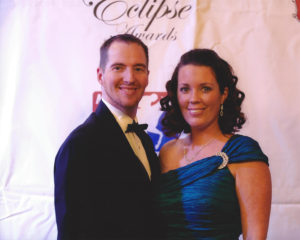 Carrie knew that, for her, remaining in the Thoroughbred industry was non-negotiable. Once she graduated from the KEMI program in the spring of 2001, she enrolled full-time at the University of Kentucky to obtain her Equine Business degree. At the same time, she began working for Flaxman Holdings part-time (30 hours a week) as an office administrator, managed a polo barn for a local Lexington polo player, and worked all of the major sales in both Kentucky and New York (we said she was driven!).
Carrie knew that, for her, remaining in the Thoroughbred industry was non-negotiable. Once she graduated from the KEMI program in the spring of 2001, she enrolled full-time at the University of Kentucky to obtain her Equine Business degree. At the same time, she began working for Flaxman Holdings part-time (30 hours a week) as an office administrator, managed a polo barn for a local Lexington polo player, and worked all of the major sales in both Kentucky and New York (we said she was driven!).
“Once I completed school, I began working for Flaxman Holdings full-time and also took many side jobs and volunteer opportunities, and I accepted board positions in varying associations, clubs, and organizations in all facets of the Thoroughbred and equine world. My husband and I opened and ran a boarding/breaking farm with part of the focus on rehabbing, retraining and selling off-the-track Thoroughbreds, which we thoroughly enjoyed.”
After 5 years of intense careers and passions, Carrie and husband Randy decided to reprioritize where they spent their time and began a family. Today, Carrie has been with Flaxman for 16 years and her job has evolved into the role of Racing, Sales and Stallion Coordinator. “The job is a smorgasbord of duties, including some of my favorite aspect of farm photographer and traveling,” she explains.
Never Stop Learning
While Carrie’s background is vast and varied through her own dedication to deepening her experiences in the Thoroughbred industry, she feels very strongly that her time in KEMI placed her on the path to success. “The exposure to top management, veterinarians, farriers and specialty fields broadened my education and my network within Kentucky, the U.S. and abroad. Just being exposed to Thoroughbred lingo, pedigrees, veterinary terms, conformation exams, radiographs, racing and technology … prepared me by increasing my knowledge base and hands-on experience.”
While Carrie recommends applying for KEMI without hesitation, she offers students—or anyone interested in the equine industry—one key piece of advice:
“Nearly everyone you will meet in the industry started off as a groom on the racetrack or a farm. It’s a ladder you must climb–and you must start at the bottom. This industry is one where it’s vital to learn as you grow. Ask any manager in Central Kentucky, and they will all say they are still learning, and they see new things every day. You learn by working, seeing and doing … you must put in the time, effort, dedication and open-mindedness–that will get you furthest in the industry. Don’t expect after a 6-month internship that you’ll be at the top of any ladder. The more time you put in, the more marketable you become.”
